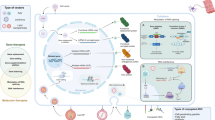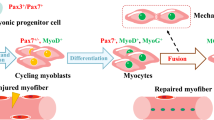Summary
A man of 68, who died from a second heart stroke had neurogenic atrophy of the legs. The anterior tibial muscle showed abundant target and targetoid fibres. Half a year prior to death he had increasing weakness and wasting of the legs. The morphometric evaluation of the target and targetoid fibres showed a considerable independence of the plane size of the single zones from the total gauge of the fibres on cross section. Only a small part of the variation in size of zone 2 (4%) depended on the size of the target, indicating that zone 2 cannot just be a passive product of a shrinkage and disappearance of the target, but that there must be an active process, which leads to the change in zone 2. The regressive development of the centrally demarcated fibrillar bundle (target) is regarded as secondary degeneration following interruption of the nutritional supply.
Similar content being viewed by others
References
Cason, J. E.: A rapid one-step Mallory-Heidenhain stain for connective tissue. Stain. Technol.25, 225–226 (1950)
Engel, W. K.: Muscle target fibers, a newly recognized sign of denervation. Nature (Lond.)191, 389–390 (1961)
Engel, W. K.: Histochemistry of neuromuscular diseases. Proc. 8. Int. Congr. Neuropath. Vienna, Neuromuscular Diseases, pp. 67–101. Amsterdam: Exerpta Medica 1965
Engel, W. K., Brooke, M. H.: Histochemistry of the myotonic disorders. In: Progressive Muskeldystrophie Myotonie, Myastoenie (ed. E. Kuhn), pp. 203–222. Berlin-Heidelberg-New York: Springer 1966a
Engel, W. K., Brooke, M. H., Nelson, P. G.: Histochemical studies of denervated or tenotomized cat muscle; Illustrating difficulties in relating experimental animal conditions to human neuromuscular diseases. Ann. N. Y. Acad. Sci.138, 160–185 (1966b)
Martin, L., Reniers, J.: Etude histoenzymatique du muscle, 1. l'amiotrophie neurogene proximale (Kugelberg-Welander). Acta Neuropath. (Berl.)9, 328–334 (1967)
Moore, M. J., Rebeiz, J. J., Hoden, M., Adams, R. D.: Biometric analysis of normal skeletal muscle. Acta neuropath. (Berl.)19, 51–69 (1971)
Resnick, J. S., Engel, W. K.: Target fibers—structural and cytochemical characteristics and their relationship to neurogenic muscle diseases and fiber types. In: Exploratory concepts in muscular dystrophy and related disorders (ed. A. T. Milhorat) Excerpta Medica (Amsterd.), Intern. Congr. Ser.147, 255–267 (1967)
Schmitt, H. P.: “Epi-” and intramedullary neurilemmoma of the spinal cord with denervation atrophy in the related skeletal muscles. J. Neurol.209, 271–278 (1975)
Schmitt, H. P.: Measurements of voluntary muscle fiber cross sections: A comparative study of different possible methods. Microsc. Acta77, 427–440 (1976)
Schmitt, H. P., Volk, B.: The relationship between target, targetoid, and targetoid/core fibers in severe neurogenic muscular atrophy. J. Neurol.210, 167–181 (1975)
Schotland, D. L.: An electron microscopic study of target fibers, target-like fibers and related abnormalities in human muscle. J. Neuropath. exp. Neurol.28, 214–228 (1969)
Shafiq, S. A., Milhorat, A. T., Gorycki, M. A.: An electron miscroscopic study of muscle degeneration and changes in blood vessels in polymyositis. J. Path. Bact.94, 139–147 (1967a)
Shafiq, S. A., Milhorat, A. T., Gorycki, M. A.: Fine structure of human muscle in neurogenic atrophy. Neurology (Minneap.)17, 934–948 (1967b)
Song, S. K., Shimada, N., Anderson, P. J.: Orthogonal diameters in the analysis of muscle fibre size and form. Nature (Lond.)200, 1220–1221 (1963)
Tomonaga, M., Sluga, E.: Zur Ultrastruktur der Targetfasern. Virchows Arch. path. Anat.348, 89–104 (1969)
Volk, B., Schmitt, H. P.: Ungewöhnliche tubuläre Strukturen in Targetfasern bei neurogener Muskelatrophie; Hypertrophie des T-Systems. Jahrestgg. Verein. Dtsch. Neuropath. Neuroanat. e. V., Köln, 2.–4. Oktober 1975 (Abstract)
Weibel, E. R., Elias, H.: Quantitative methods in morphology. Berlin-Heidelberg-New New York: Springer 1967
Author information
Authors and Affiliations
Additional information
Vorgetragen auf der Jahrestagung der Vereinigung Deutscher Neuropathologen und Neuroanatomen e. V., Köln, 2.–4. Oktober 1975.
Rights and permissions
About this article
Cite this article
Schmitt, H.P. Considerations on the morphogenesis of target and targetoid fibres based on morphometric investigations. Acta Neuropathol 35, 109–116 (1976). https://doi.org/10.1007/BF00690557
Received:
Accepted:
Issue Date:
DOI: https://doi.org/10.1007/BF00690557




